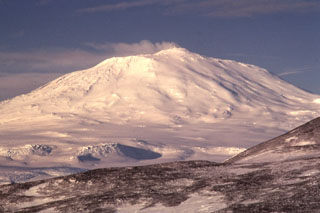Report on Erebus (Antarctica) — January 1987
Scientific Event Alert Network Bulletin, vol. 12, no. 1 (January 1987)
Managing Editor: Lindsay McClelland.
Erebus (Antarctica) Mild Strombolian activity at lava lake
Please cite this report as:
Global Volcanism Program, 1987. Report on Erebus (Antarctica) (McClelland, L., ed.). Scientific Event Alert Network Bulletin, 12:1. Smithsonian Institution. https://doi.org/10.5479/si.GVP.SEAN198701-390020
Erebus
Antarctica
77.53°S, 167.17°E; summit elev. 3794 m
All times are local (unless otherwise noted)
"Mount Erebus has been in continuous eruption since 1972, when a small anorthoclase phonolite lava lake was discovered. The semi-circular lava lake reached about 60 m in diameter. A major increase in the size and number of Strombolian eruptions occurred September-December 1984 and buried the lake with ejecta. A rough estimate suggests 100,000 m3 of phonolite was ejected.
"Since late 1984, activity has reverted to the daily mild Strombolian eruptions observed prior to that time. The former lava lake and associated vents are slowly being exhumed. Observations in December 1986 showed a small, pear-shaped lava lake about 20 m long, and several associated small hornitos and/or small lava pools. The Active Vent, a small explosive vent adjacent to the lava lake, commenced minor ash eruptions. SO2 emissions were monitored in December by COSPEC and ranged from 4 to 40 t/d with an average emission of about 20 t/d.
"The 10-station seismic array established as part of the International Mount Erebus Seismic Study was partially dismantled because of funding problems. Signals from a single seismic station are currently being recorded on a modified helicorder which will operate for 72 hours without maintenance."
Geological Summary. Mount Erebus, the world's southernmost historically active volcano, overlooks the McMurdo research station on Ross Island. It is the largest of three major volcanoes forming the crudely triangular Ross Island. The summit of the dominantly phonolitic volcano has been modified by one or two generations of caldera formation. A summit plateau at about 3,200 m elevation marks the rim of the youngest caldera, which formed during the late-Pleistocene and within which the modern cone was constructed. An elliptical 500 x 600 m wide, 110-m-deep crater truncates the summit and contains an active lava lake within a 250-m-wide, 100-m-deep inner crater; other lava lakes are sometimes present. The glacier-covered volcano was erupting when first sighted by Captain James Ross in 1841. Continuous lava-lake activity with minor explosions, punctuated by occasional larger Strombolian explosions that eject bombs onto the crater rim, has been documented since 1972, but has probably been occurring for much of the volcano's recent history.
Information Contacts: P. Kyle, New Mexico Institute of Mining and Technology.

